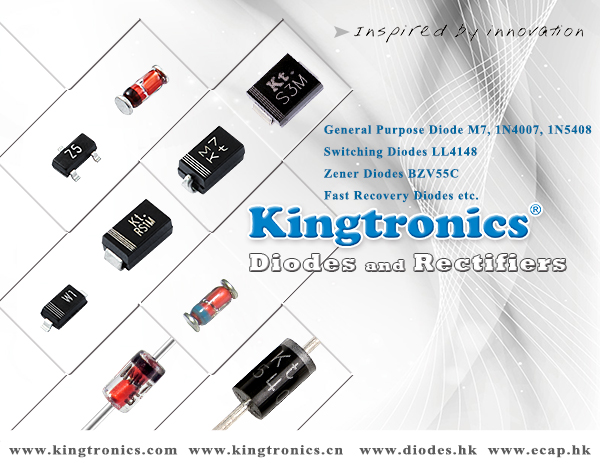Kt Kingtronics Introduction of Diodes
Diode is a dual electrode electronic component with asymmetric conductivity. When conducting forward, there is an infinitesimal resistance between its two electrodes (anode and cathode), while in reverse, there is an infinitesimal resistance, meaning that current is only allowed to flow through the diode in a single direction.
In 1874, German physicist Karl Braun discovered the rectification ability of crystals. Therefore, the first generation diode developed in 1906, the "cat whisker diode," was made from mineral crystals such as galena. Early diodes also included vacuum tubes, which had two electrodes, an anode, and a thermal cathode. After the discovery of semiconductor performance, diodes became the world's first semiconductor device. Nowadays, most diodes are produced using silicon, and other semiconductor materials such as selenium or germanium are sometimes also used. The most common structure currently is a semiconductor performance junction chip connected to two electrical terminals through a PN junction.
Function A diode has two terminals, anode and cathode, and current can only flow in a single direction. That is to say, current can flow from the anode to the cathode, but not from the cathode to the anode. The application of the unidirectional characteristic possessed by diodes is commonly referred to as the "rectification" function. In a vacuum tube, the voltage applied between the electrodes can allow hot electrons to travel from the cathode to the anode, thus having a rectifying effect. The conversion of alternating current to direct current, including the modulation of radio signals by radio receivers, is achieved through rectification.
Due to its characteristic of blocking forward and reverse flow, diodes can be thought of as electronic versions of check valves. However, in reality, diodes do not exhibit such perfect switching performance, but rather exhibit complex nonlinear electronic characteristics determined by specific types of diode technology. Generally speaking, the diode will only start working when the threshold voltage is reached in the forward direction (this state is called forward bias). The voltage drop at both ends of a forward biased diode is only slightly related to the current and is a function of temperature. Therefore, this feature can be used for temperature sensors or reference voltages.
The nonlinear current voltage characteristics of semiconductor diodes can be changed by selecting different semiconductor materials and doping different impurities to form impurity semiconductors. In addition to being used as a switch, diodes with changed characteristics also have many other functions, such as adjusting voltage (Zener diodes), limiting high voltage to protect circuits (avalanche diodes), radio tuning (varactor diodes), generating radio frequency oscillations (tunnel diodes, Gunn diodes, IMPATT diodes), and generating light (light-emitting diodes).
In semiconductor diodes, there are types that utilize the PN junction effect of P-type and N-type semiconductor interfaces, as well as the Schottky effect generated by metal semiconductor bonding to achieve rectification. If it is a PN junction diode, it is the anode on the P-type side and the cathode on the N-type side.
Kingtronics Hot product line【Diode Rectifier,Transistor】-1N4148W, BZX84C,ES2A, RS1A, SS12,SS22, US1A:
https://www.youtube.com/watch?v=Si3wc4ZnXyE
Contact us today for best offer: info@kingtronics.com Skype: kingtronics.sales2










